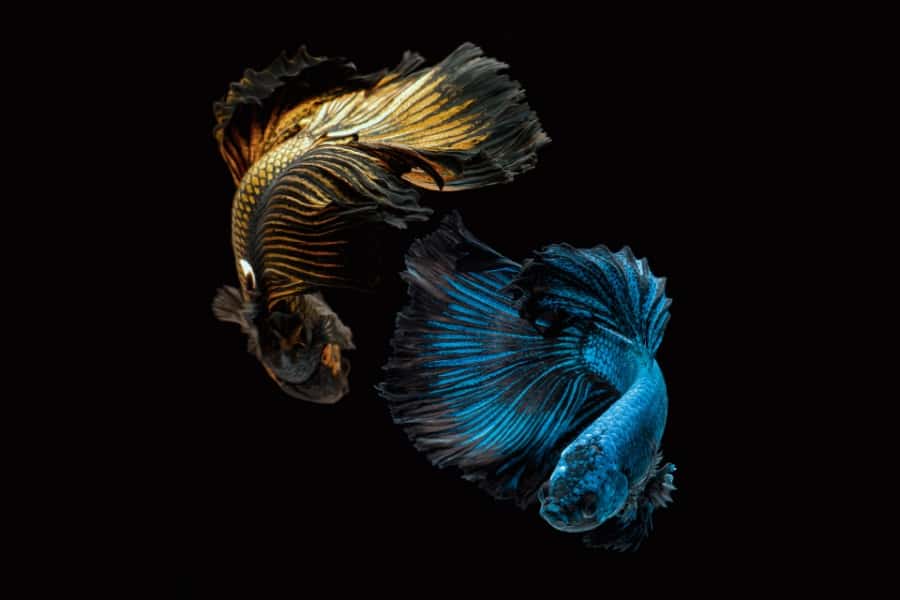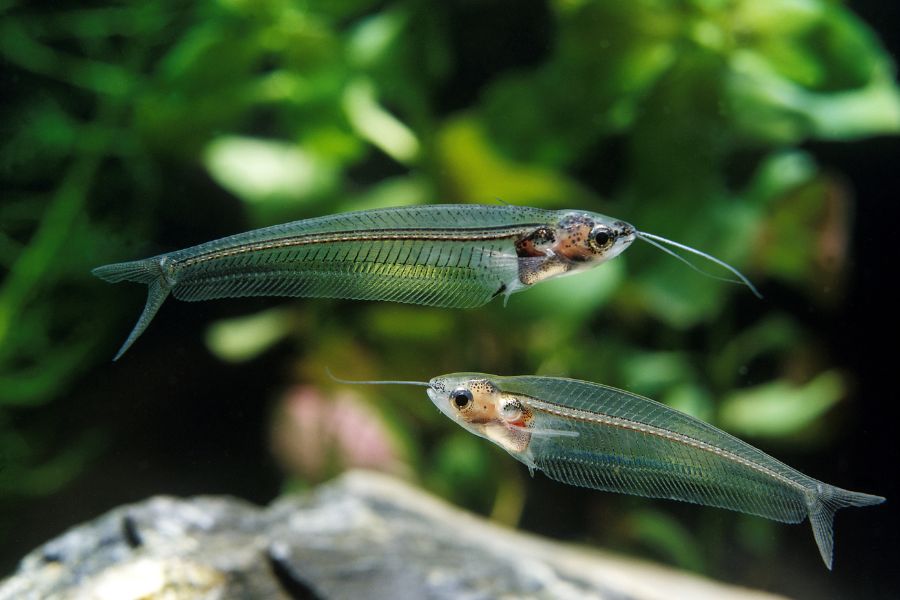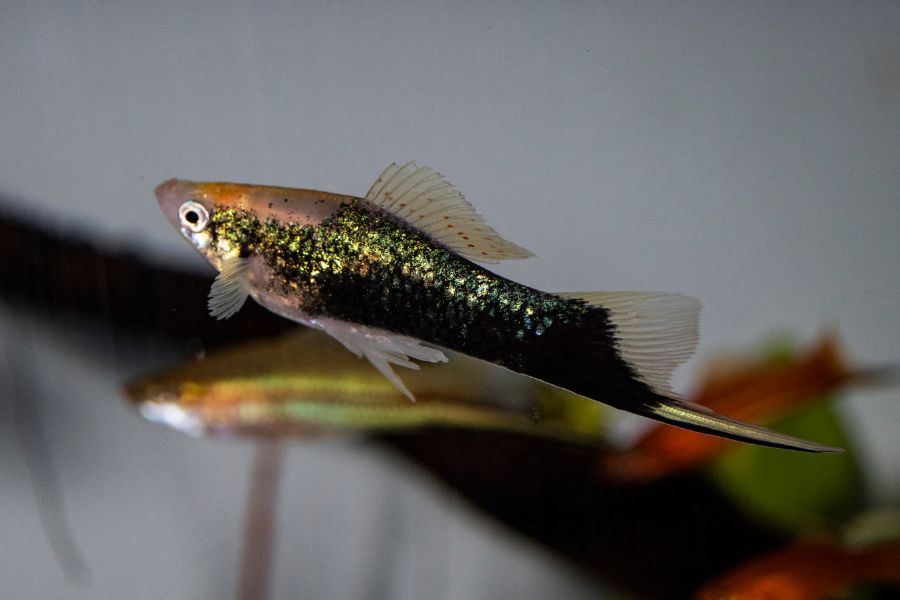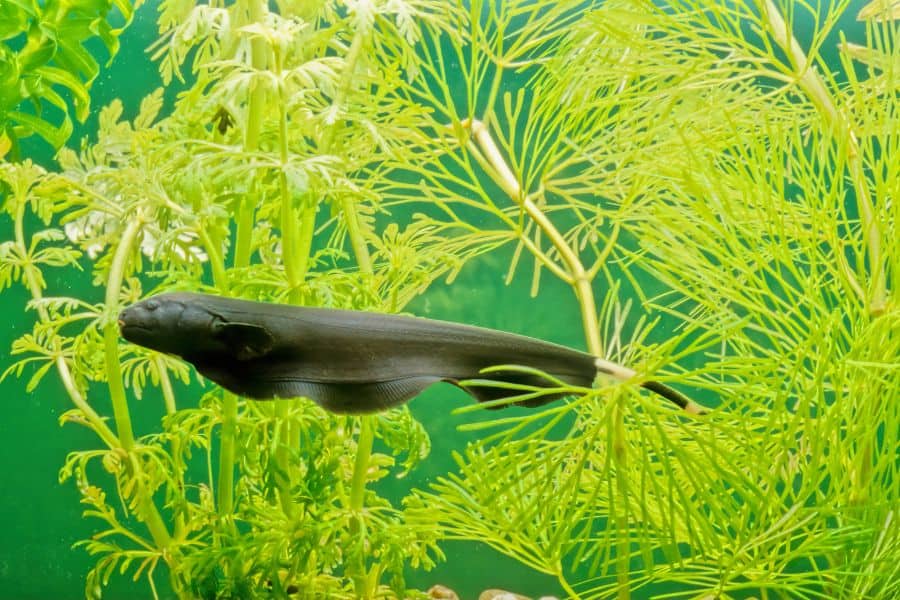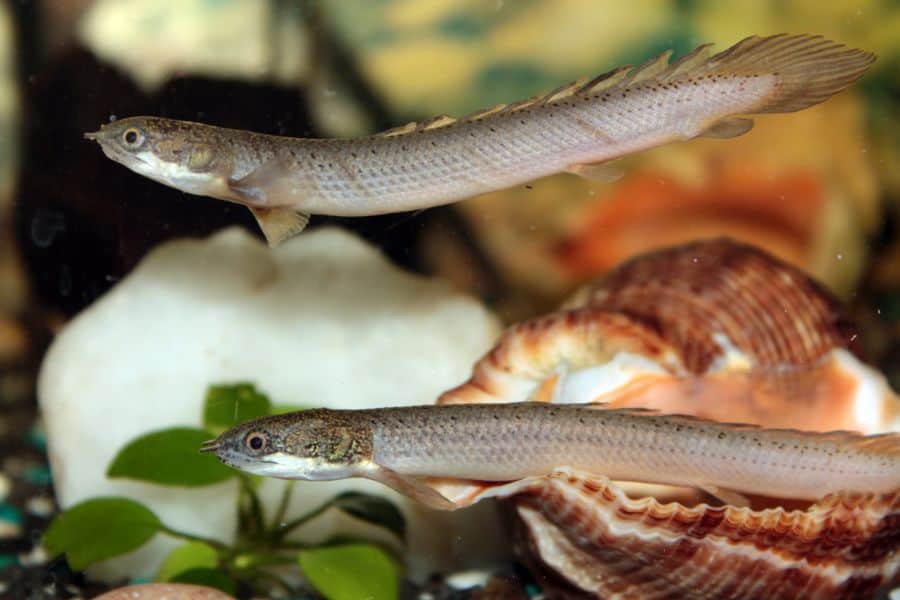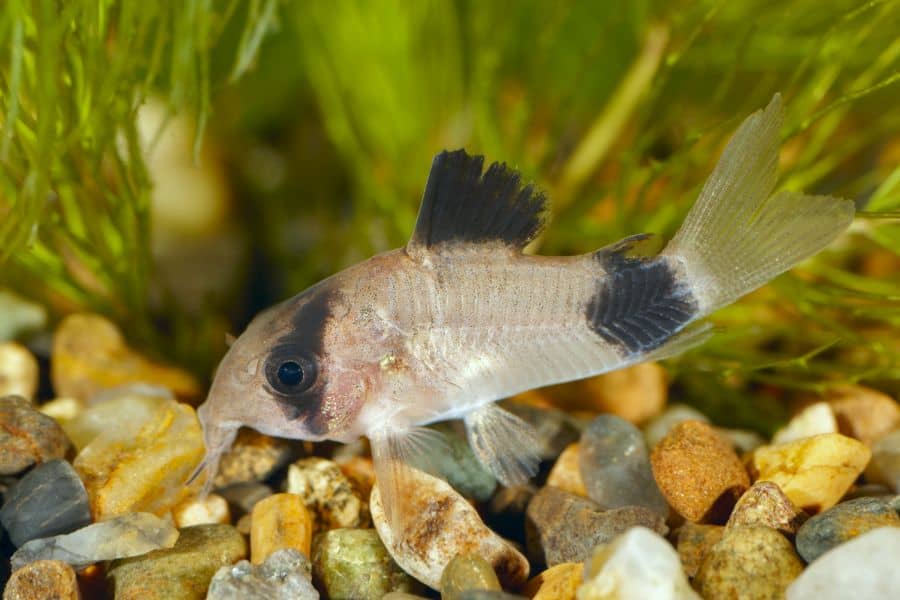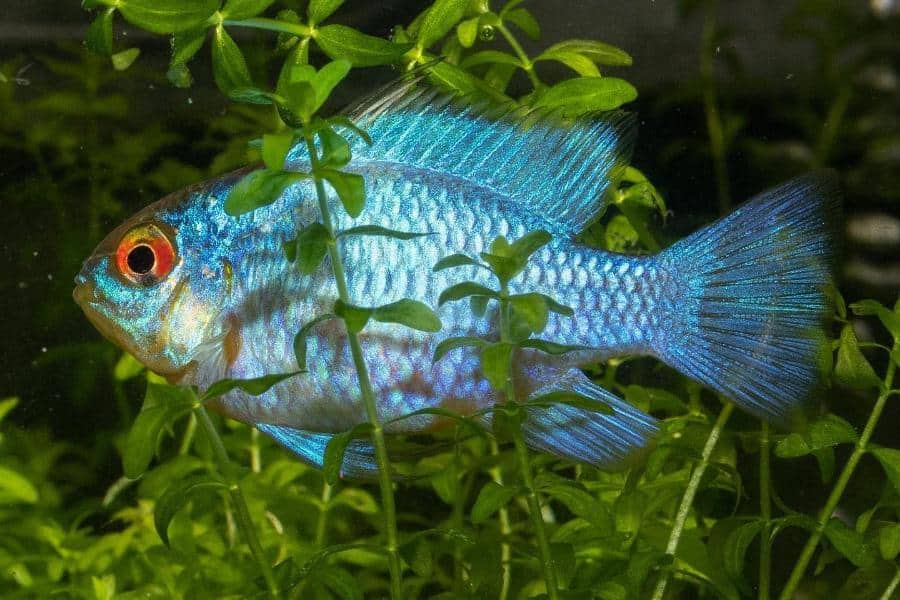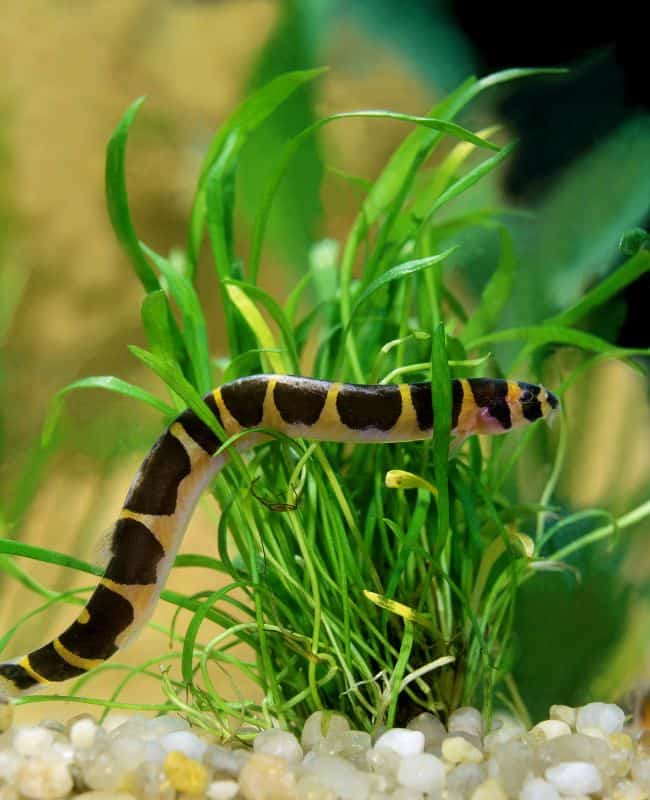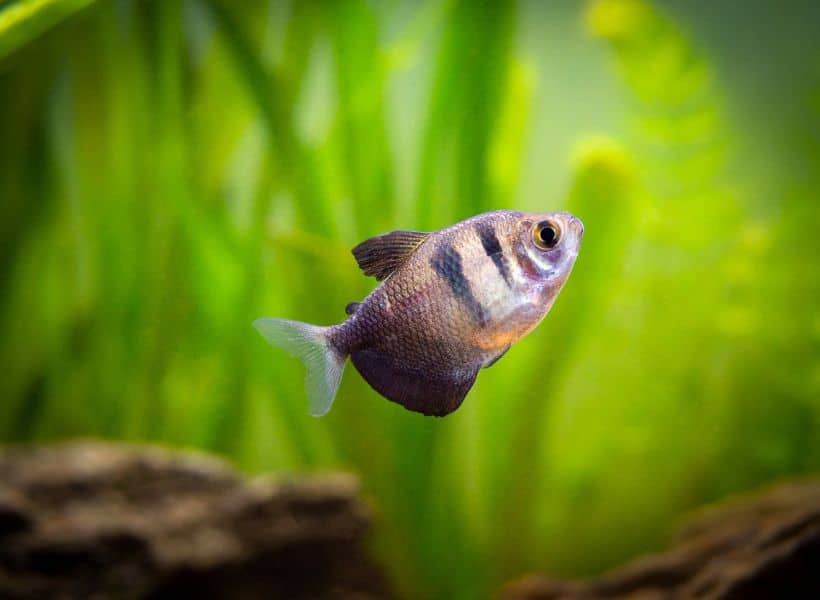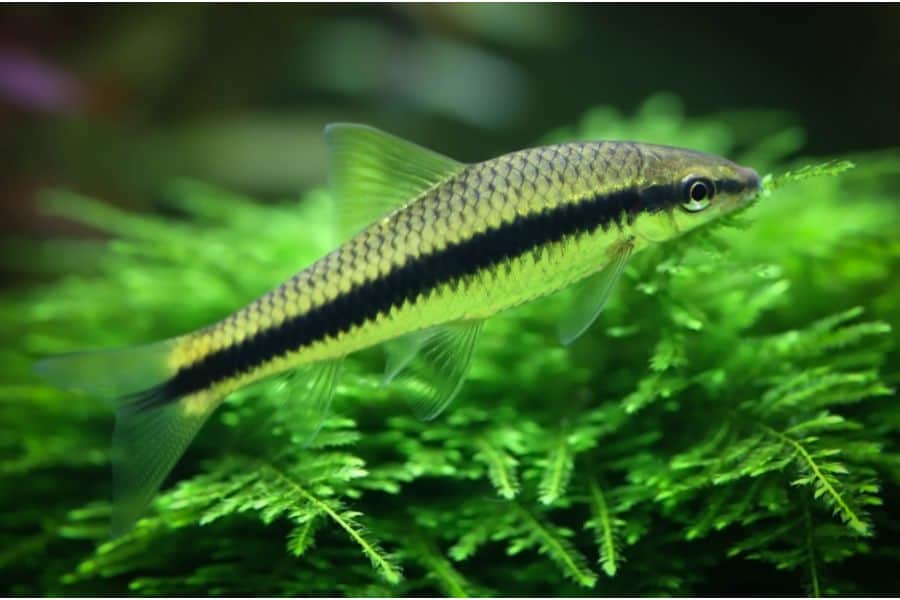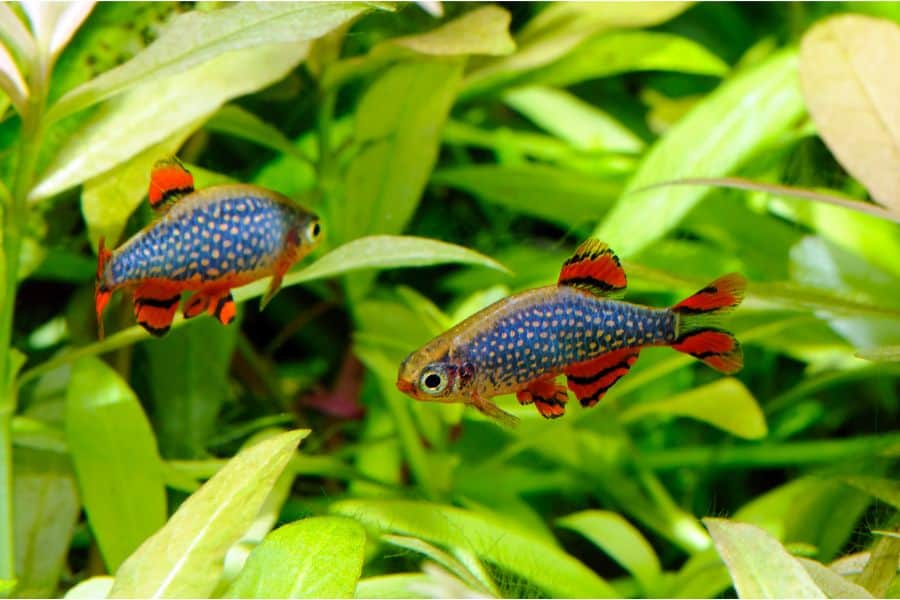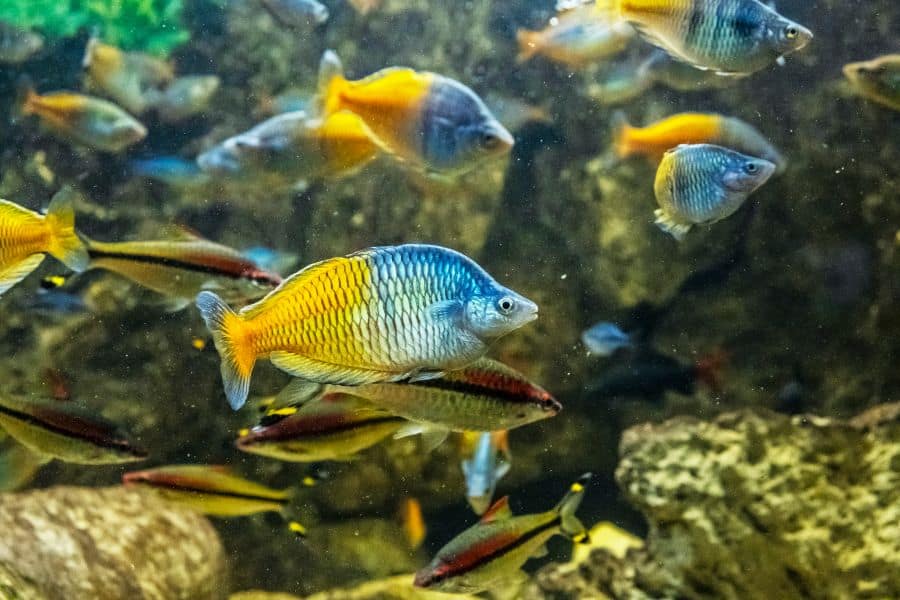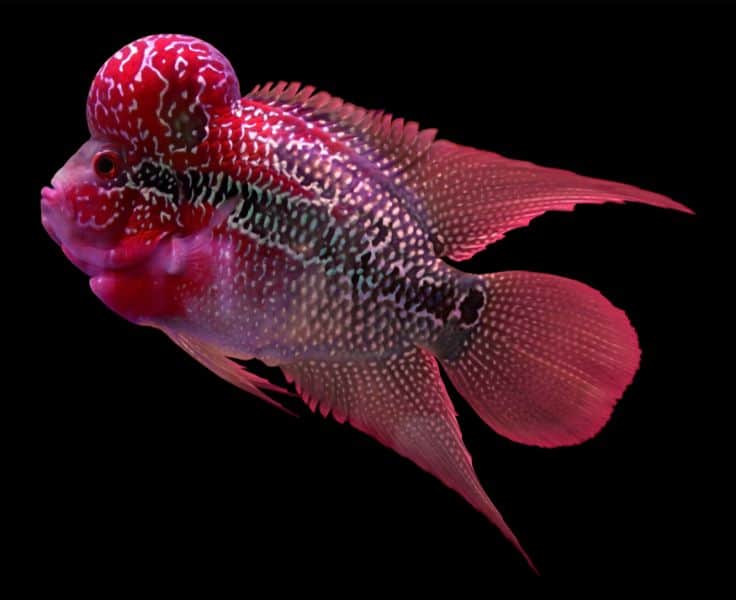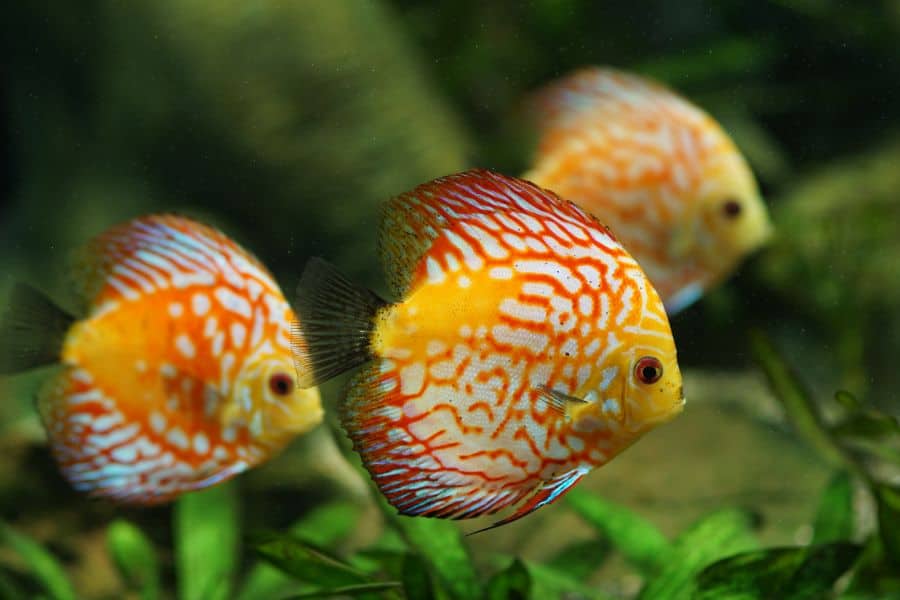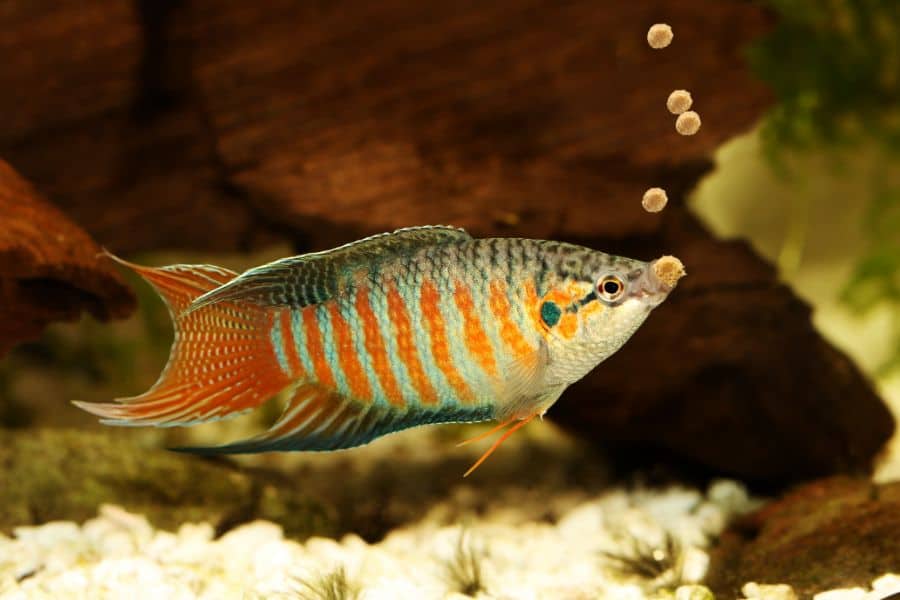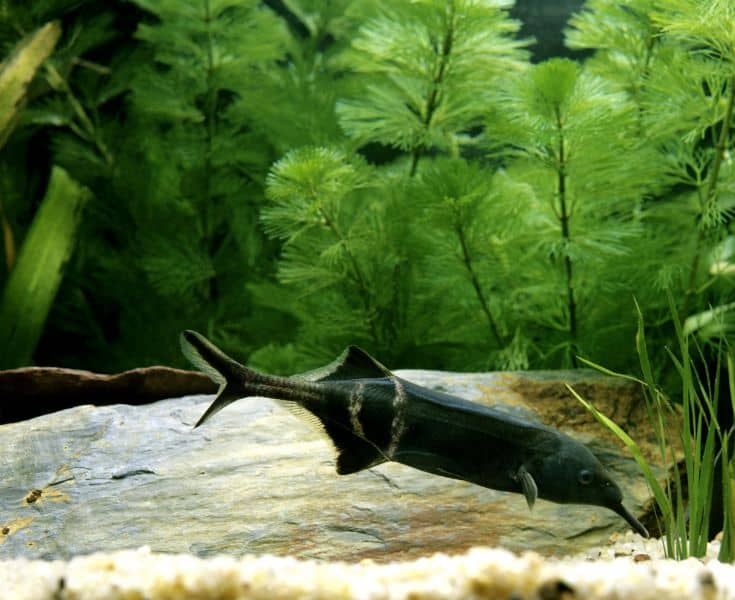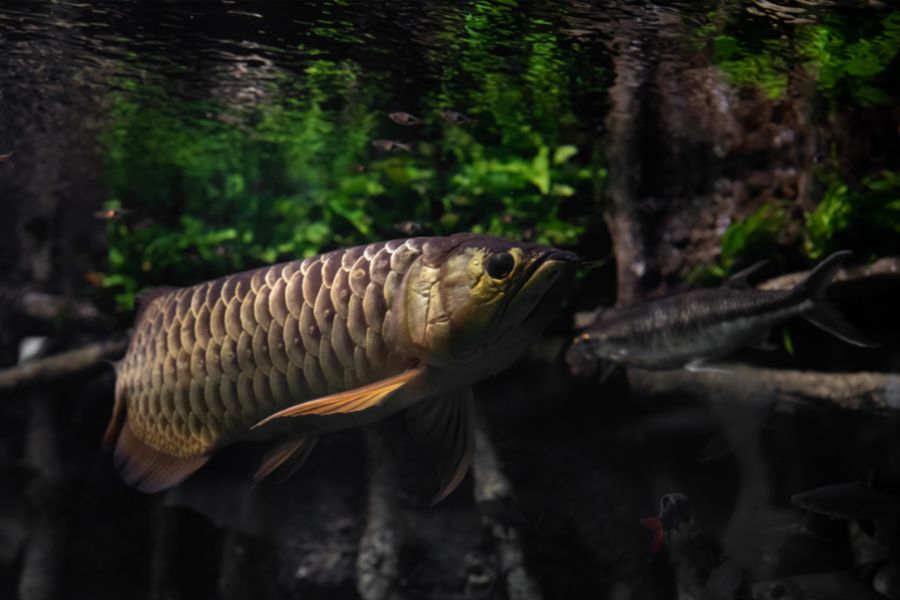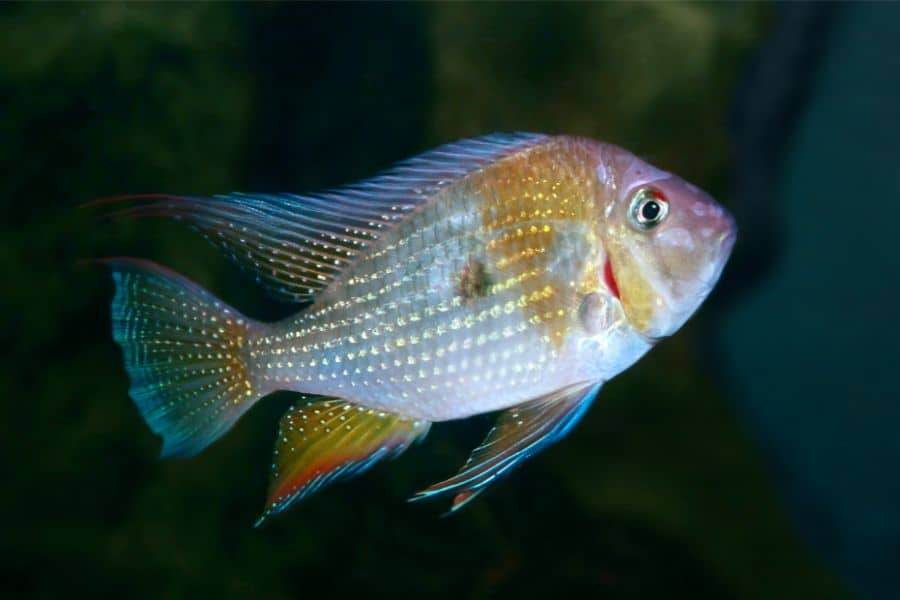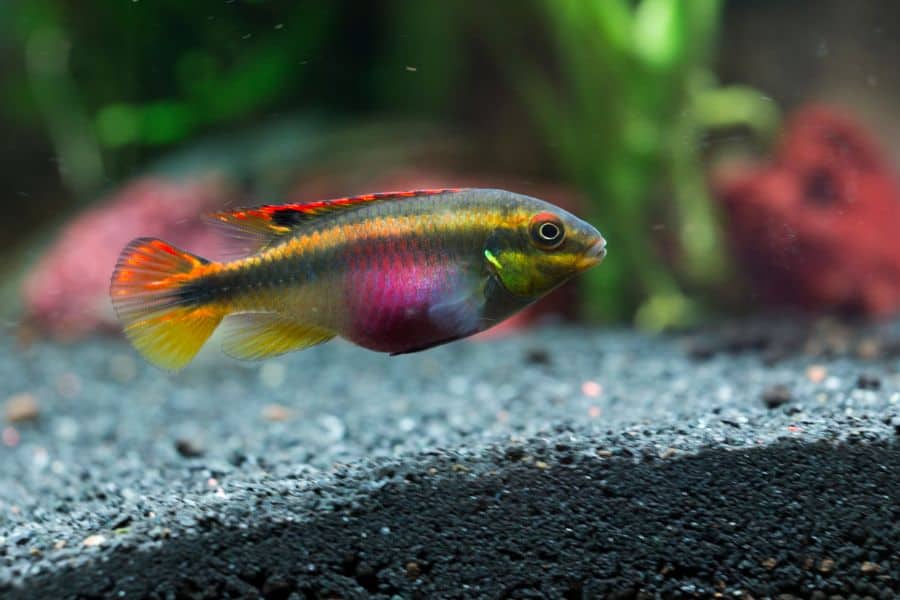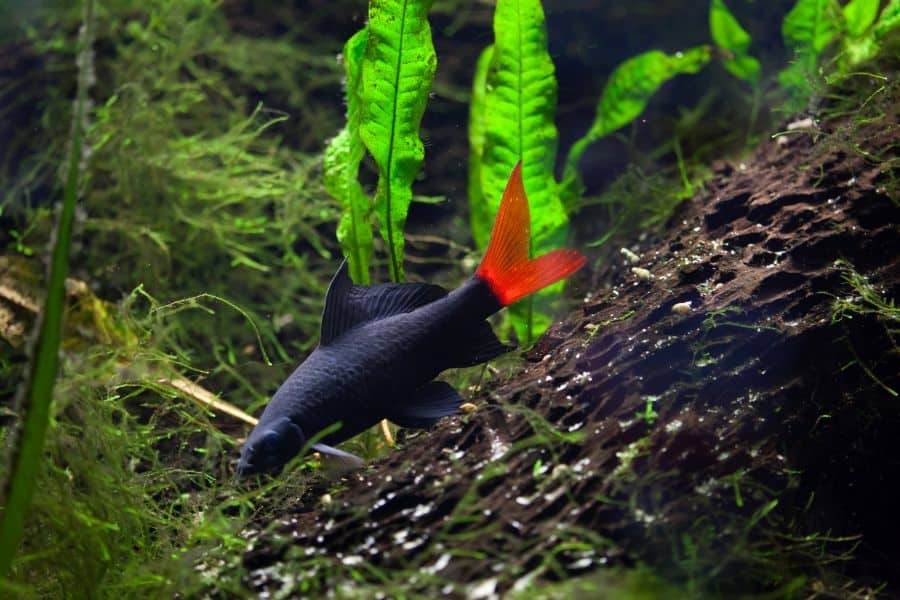Discovering the wonders of the underwater world from the comfort of your home is a captivating experience – and setting up a freshwater aquarium can be a rewarding journey for any fishkeeping beginner.
But with an abundance of fascinating options, it can certainly be overwhelming to decide which fish species to keep.
In this article, we present the 30 coolest freshwater fish that are not only beautiful but also ideal for novice aquarists. Delve into the enchanting diversity of colors, shapes, and behaviors as we explore the perfect aquatic companions to grace your home aquarium!
30 Coolest Freshwater Fish
1. Betta Fish (Betta splendens)
- Care Difficulty: Intermediate
- Adult Size: 2 to 3 inches
- Ideal Minimum Tank Size: 5 gallons
- Minimum Number: 1
- Temperament: Territorial
- Heater: Yes (78-80°F)
Betta fish, also known as Siamese Fighting Fish, are world-famous for their vibrant colors and flowing fins that captivate aquarium enthusiasts.
Their mesmerizing tails and territorial behavior certainly grab your attention, but their vast genetic diversity makes them very popular among hobbyists.
It helps that there are many betta varieties and sub-varieties out there – which means true-blue Betta enthusiasts will never run out of variants to collect, breed, or adopt into their home aquarium.
Betta fish are relatively easy to care for, making them perfect for beginners. That said, if you’re new to the hobby, it’s best to keep male Bettas in solo tanks, as their territorial nature can result in fights and brawls with their fellow tank mates. They can also be kept with non-aggressive invertebrates like snails or shrimp.
They thrive in warm water (around 78-80°F) and enjoy well-planted aquariums with plenty of hiding spots and natural decorations like driftwood and moss balls.
2. Glass Catfish (Kryptopterus vitreolus)
- Care Difficulty: Moderate
- Adult Size: Up to 5 inches
- Ideal Minimum Tank Size: 30 gallons
- Minimum Number: At least 5
- Temperament: Peaceful
- Heater: No
The Glass catfish is a fascinating freshwater fish with translucent, almost see-through bodies. Their transparent appearance and unique swimming style, moving both horizontally and vertically, make them stand out in any aquarium.
Glass catfish do best in well-maintained aquariums with subdued lighting and plenty of hiding spots. Be careful not to have sudden fluctuations in water parameters, such as temperature, pH, or even water flow.
Due to their peaceful and social nature, they’re well-liked by both beginner and experienced hobbyists. However, they do enjoy being in groups of at least five, which means you’ll need a larger tank to satisfy their basic space requirements.
If you can keep them in a large tank with a very stable environment, this species will surely be attention-grabbers in their display tanks.
3. Swordtail (Xiphophorus hellerii)
- Care Difficulty: Easy
- Adult Size: Up to 6 inches
- Ideal Minimum Tank Size: 15 gallons
- Minimum Number: 1 male per 2 females
- Temperament: Generally peaceful but can be aggressive
- Heater: No
Swordtails are popular among aquarium keepers for their extraordinary sword-shaped tail fins, adding elegance to their appearance. They come in various colors – the dark orange and red ones being the most popular.
Swordtails are hardy and adaptable fish, making them suitable for beginners. They prefer a well-maintained aquarium with live plants and open swimming areas. A varied diet and regular water changes ensure their health and vibrant colors.
Swordtails are generally peaceful and can be kept with other peaceful community fish, such as mollies, tetras, and guppies. However, bigger males tend to become territorial over time. They’re prone to harassing other males and even females, especially during the breeding season.
They’re also promiscuous breeders, and they bear live young, which means your aquarium can have the very real danger of overpopulating if enough of the fry survive to adulthood.
4. Glofish
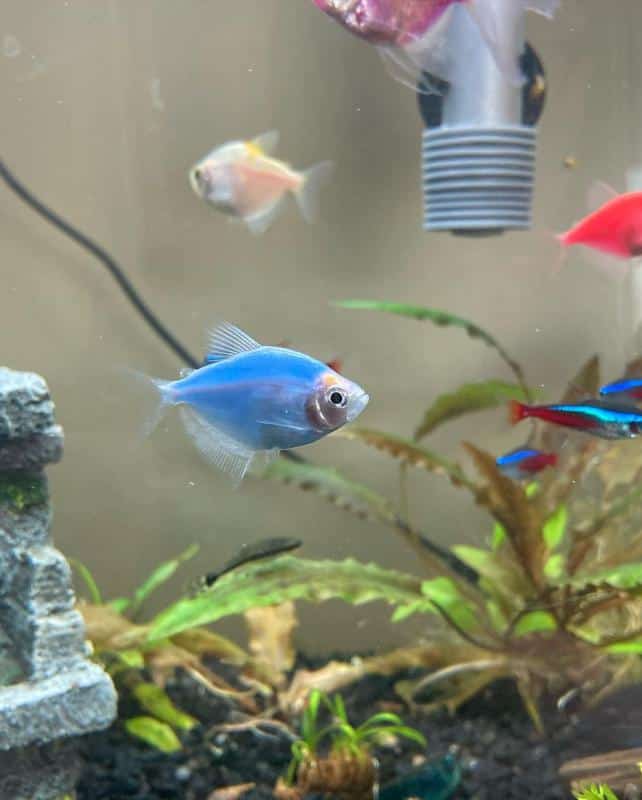
- Care Difficulty: Beginner
- Adult Size: Varies depending on fish species
- Ideal Minimum Tank Size: Varies depending on fish species
- Minimum Number: At least six
- Temperament: Generally peaceful
- Heater: No
Glofish are genetically modified fishes that glow in vibrant fluorescent colors, like neon pink, green, and orange, making them a standout addition to aquariums. Their hardy nature and eye-catching appearance have made them highly popular in the hobbyist community.
Contrary to popular belief, though, glofish is an umbrella term for many different species genetically modified to make them glow in the dark. They were originally developed in labs to study genetics, but their show-stealing appearance welcomed them to the aquarium community.
Some of the most popular glofish varieties include tetras and zebrafish, which are easy to care for and can thrive in a well-maintained tank with standard freshwater conditions. They’re peaceful and can coexist with other non-aggressive community fish like tetras and barbs. They’re omnivorous and eat just as well as any other kind of fish.
If you really want to highlight their unique features, consider adding black light or blue light to your freshwater aquarium. With their glowing beauty, creating a mesmerizing underwater spectacle has never been easier.
5. Black Ghost Knife Fish (Apteronotus albifrons)
- Care Difficulty: Moderate to Difficult
- Adult Size: Up to 20 inches
- Ideal Minimum Tank Size: 100 gallons
- Minimum Number: 1
- Temperament: Predatory
- Heater: No
The black ghost knife fish stands out with its sleek eel-like matte black body, shimmering silver highlights, and large flowing tail resembling a ghostly veil. Its unique appearance and nocturnal nature make it a captivating and sought-after species among experienced aquarists.
This isn’t the only that makes this species special, though. Black ghost knife fish also use the electricity they generate from their tails to “feel” the world around them, even in the dark. Luckily for their potential tank mates, this electric charge isn’t strong enough for hunting prey. However, they’re still skilled enough to catch and eat smaller tank mates that can fit inside their mouths.
Keep in mind that these fishes can grow to a whopping 20 inches, so it’s best to prepare a proper home for them before you even think about buying them.
They require a large, well-maintained tank with plenty of hiding spots, subdued lighting, and controlled water quality and parameters. Those who meet these stringent requirements will reap the benefits of its show-stopping aesthetics and interesting personality.
6. Bichir (Polypterus delhezi / Polypterus senegalus)
- Care Difficulty: Difficult
- Adult Size: 10-30 inches
- Ideal Minimum Tank Size: 90 gallons
- Minimum Number: 1
- Temperament: Predatory
- Heater: No
Bichirs, also known as dinosaur eels, have a unique prehistoric appearance with elongated bodies covered in armor-like scales and distinctive lobed fins. Their ancient look and fascinating behavior make them popular choices for advanced aquarists.
Bichirs are hardy and can tolerate a wide range of water conditions, but they require seriously spacious tanks with ample hiding spots and a tight-fitting lid as they’re skilled jumpers.
They’re also carnivorous and can be fed with frozen or live foods, so you need to keep them away from small fish that they can hunt as prey. Keeping them with larger, non-aggressive tank mates like cichlids or catfish is best.
Like the black ghost knife fish, the bichir is a demanding species with very specific care requirements. But if you can meet this living dinosaur’s care requirements, they’ll surely be your collection’s centerpiece for years.
7. Panda Corydoras (Corydoras panda)
- Care Difficulty: Easy
- Adult Size: 2 inches
- Ideal Minimum Tank Size: 10 gallons
- Minimum Number: 6
- Temperament: Peaceful
- Heater: No
Panda corydoras are adorably small catfish perfect for any community aquarium. True to their name, they look like a panda – with noticeable black patches on their eyes and around their body over a contrasting white primary coloration. This charming appearance and their peaceful nature have made them popular in the aquarium hobby.
Panda corys are social creatures, so you need to keep them in groups of at least six is recommended. Any less than this isn’t recommended since they can get stressed out without the comfort and safety provided by their group.
They prefer soft, acidic water and thrive in well-maintained planted tanks. They like grazing the substrate with their sensitive barbels, so your aquarium should have soft or fine substrate such as aquarium soil or sand.
As omnivores, they enjoy a varied diet of sinking pellets, flakes, vegetables, and live or frozen foods. These traits enable them to coexist with other peaceful fish and invertebrates, making them very popular choices for community tanks.
8. Electric Blue Ram (Mikrogeophagus ramirezi)
- Care Difficulty: Intermediate
- Adult Size: 2-3 inches
- Ideal Minimum Tank Size: 20 gallons
- Minimum Number: 2
- Temperament: Peaceful
- Heater: Yes (80–86°F)
Electric blue rams, a color variation of the German blue ram, are renowned for their vibrant blue coloration and aesthetically pleasing long-rayed fins. Their stunning appearance and peaceful behavior make them highly sought after in the aquarium trade.
One interesting aspect about them is that their brilliant blue coloration results from years of selectively breeding German blue rams, so you won’t find this coloration in the wild.
Electric blue rams are relatively easy to care for but require stable water conditions, which means they don’t respond well to sudden fluctuations. They prefer soft and slightly acidic water and a well-planted tank that mimics their natural habitat.
Ideally, you should get them in pair, as they’re extremely social creatures that can get stressed without a partner or group. They can be kept with other non-aggressive tank mates such as tetras, dwarf gouramis, or other small and peaceful cichlid species.
9. Kuhli Loach (Pangio kuhlii)
- Care Difficulty: Difficult
- Adult Size: 3–4 inches
- Ideal Minimum Tank Size: 20 gallons
- Minimum Number: 6
- Temperament: Peaceful
- Heater: Yes (73–86°F)
Kuhli loaches are slender, eel-like fish with a unique appearance, featuring fascinating patterns of alternating black and orange bands. They’re both very playful and very secretive, depending on their individual personality.
Some Kuhli loaches aren’t as shy and are willing to come out of their hiding places and play in the substrate. On the other hand, others are extremely averse to attention and can disappear from your sight for days.
They prefer a well-planted tank with hiding spots like caves or driftwood. Be careful about your choice of substrate, as they enjoy burrowing in soft substrates and might hurt themselves if you have a rougher substrate, like gravel or crushed corals.
Their contrasting and highly individualistic nature has made them a favorite among aquarists. They should be kept in groups of at least six to feel secure. They’re also compatible with other peaceful community fish as long as they won’t be harassed or annoyed.
10. Black Skirt Tetra (Gymnocorymbus ternetzi)
- Care Difficulty: Easy
- Adult Size: 1-2.5 inches
- Ideal Minimum Tank Size: 15 gallons
- Minimum Number: 6
- Temperament: Peaceful
- Heater: No
Black skirt tetras boast long, black anal fins that follow the length of their body, creating a skirt-like appearance. These skirts contrast beautifully against their silver-and-black body, giving them a cute namesake.
Black skirt tetras are hardy and suitable for beginners. They thrive best in a well-maintained community tank with a variety of compatible tank mates, such as other tetras, barbs, or danios. Their elegant and active schooling behavior adds liveliness to any aquarium.
They’re omnivores and have no special considerations regarding diet, so they will accept a range of flake, pellet, and live foods.
Keeping them in a group of at least six helps reduce stress and allows them to display their natural schooling behavior. However, they will also shoal with other tetras, so it’s pretty easy to find a combination that will work for you.
11. Honey Gourami (Trichogaster chuna)
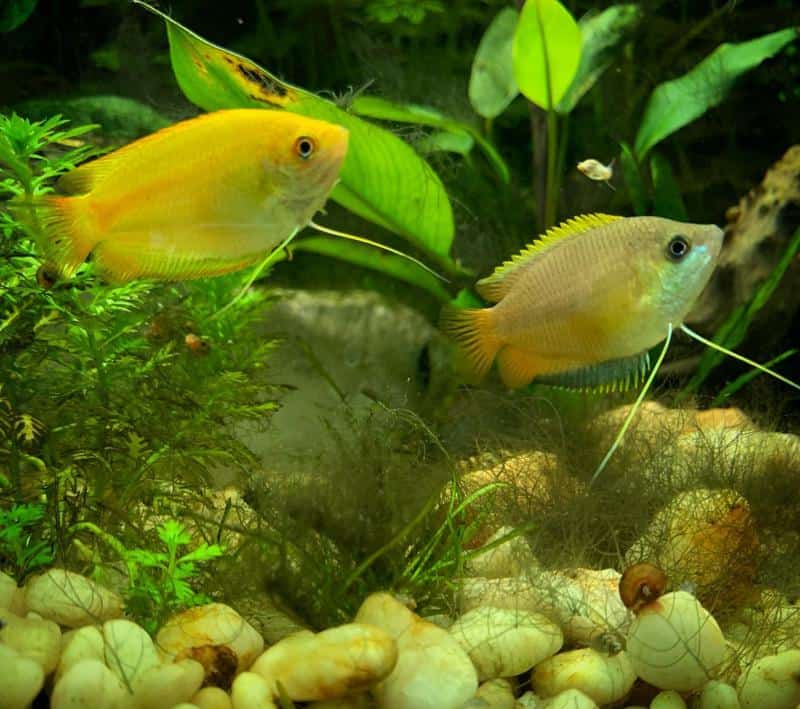
- Care Difficulty: Easy
- Adult Size: 3 inches
- Ideal Minimum Tank Size: 10 gallons
- Minimum Number: 1, but a pair is recommended
- Temperament: Peaceful
- Heater: Yes (79-84°F)
Honey gouramis, also known as sunset gouramis, are small, peaceful labyrinth fish with stunning colors. Their honey or orange-gold hue makes them captivating additions to planted community tanks, as their coloration will surely stand out against the greenery.
Like Betta fish, they’re labyrinth fishes, meaning they have specialized organs that let them breathe in air directly from the surface of the water. This allows them to survive for short periods of time in non-ideal situations.
Hardy and undemanding, they’re relatively easy to care for, making them perfect for beginners. They’re also hardy and undemanding. They’re compatible with peaceful fish like tetras, rasboras, and other gourami species, but they can be quite timid.
They appreciate a well-planted aquarium with floating plants for their bubble-nest-building behavior during the breeding season. High-quality flakes, pellets, and frozen food will keep them happy, but having small live foods they can hunt will significantly enrich their lives.
12. Pea Puffers (Carinotetradon travancoricus)
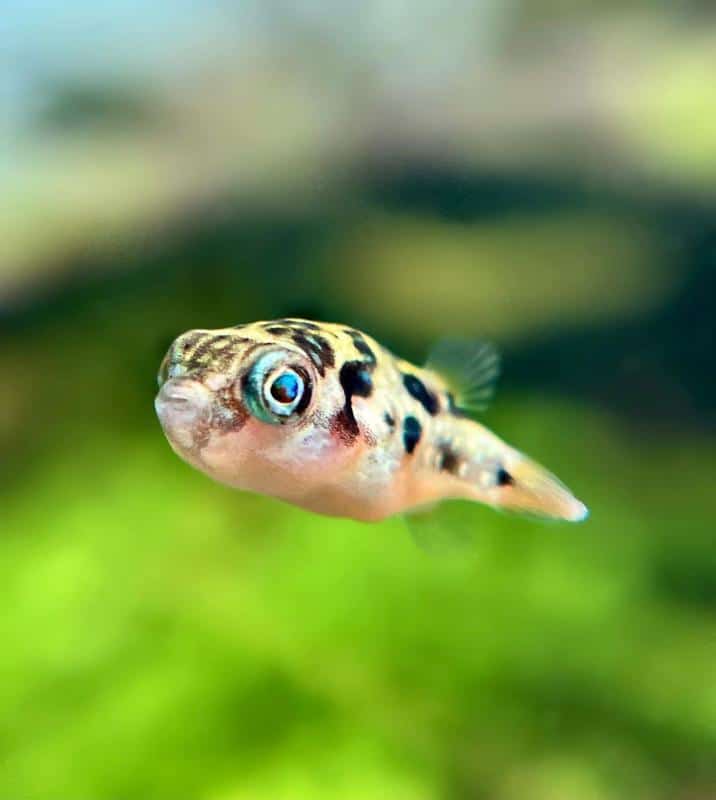
- Care Difficulty: Intermediate
- Adult Size: 4 inches
- Ideal Minimum Tank Size: 5 gallons
- Minimum Number: 1
- Temperament: Aggressive and predatory
- Heater: No
Pea puffers, also known as dwarf puffers, are tiny, vibrant fish with charismatic personalities. They have an adult size of only 1.4 inches, but their small frames are filled with mesmerizing iridescent hues and interesting yellow, green, and sometimes blue patterns.
Despite their small size, they pack a lot of character. They’re known to be highly inquisitive, curious, and aware of their surroundings. They’re also very active swimmers, so they need plenty of space to explore.
Pea puffers are best kept in species-only tanks or with other fast-swimming companions. They’re known for their carnivorous nature and hunting persistence – and they will surely take matters into their own hands (or fins) if left hungry for too long.
They’re challenging to keep due to their sensitivity to water quality, so regular water changes are essential. They also don’t handle imbalances or fluctuations well. With proper care, though, these puffers will delight aquarists with their curious and interactive behavior.
Also Read: Popular Freshwater Puffer Fish
13. Siamese Algae Eater (Crossocheilus oblongus)
- Care Difficulty: Easy
- Adult Size: 6 inches
- Ideal Minimum Tank Size: 25 gallons
- Minimum Number: 1
- Temperament: Peaceful
- Heater: No
The Siamese algae eater is a hardworking fish that helps keep aquariums free from algae. This species is often mistaken for the Chinese Algae Eater, which, although similar in appearance, has different patterns and is more prone to aggressiveness.
Their sleek, silver body and distinctive black and white stripes make them practical and visually appealing. They’re peaceful and can be kept in community tanks with other non-aggressive fish.
They thrive in well-maintained tanks with ample algae growth, but supplementary feedings like algae wafers, pellets, or vegetables are necessary if algae levels are insufficient.
Their eating habits and peaceful temperament have earned them a place in many community aquariums, and their appearance and size make them a great centerpiece for any tank.
Take note that Siamese algae eaters can grow quite large, at 6 inches in their maximum adult size. Don’t be fooled – they’re often sold in their juvenile states in pet shops. Make sure you prepare a big tank for this active tank cleaner.
14. Celestial Pearl Danio (Danio margaritatus)
- Care Difficulty: Moderate
- Adult Size: 75–1 inch
- Ideal Minimum Tank Size: 10 gallons
- Minimum Number: 6
- Temperament: Peaceful
- Heater: No
The Celestial Pearl Danio, also known incorrectly as galaxy rasbora or microrasbora, is a small, jewel-like fish with striking colors and patterns. Its shimmering pearly spots over a thick blue-black band set in a pearlescent body mimic a starry night sky, hence the name “celestial.”
These danios are peaceful, although they’re fast-swimming and active. They’re best kept with other community fishes and invertebrates. They prefer well-planted aquariums with moderate to low lighting and soft, slightly acidic water. Celestial pearl danios are omnivores, accepting a variety of dry, frozen, and live foods.
However, these fishes are extremely shy and can easily fall ill when in the presence of stressors. Keep them away from aggressive tank mates and keep their environment stable if you want them to thrive in your aquarium.
Another notable thing about this species is that they’re suitable for nano tanks and smaller community tanks. They add a touch heavenly of brilliance to any aquascape.
15. Rainbowfish (Melanotaenia spp.)
- Care Difficulty: Easy
- Adult Size:4 – 7.9 inches
- Ideal Minimum Tank Size: 15–30 gallons
- Minimum Number: 6
- Temperament: Peaceful
- Heater: No
Rainbowfish are a diverse group of colorful and lively fish of various species and patterns. Interestingly, species categorized as rainbowfish can be found in a wide variety of locations across the globe, from Australia to Indonesia.
Their iridescent scales reflect a spectrum of colors, which gives them a unique and highly attention-grabbing beauty. There are all kinds of shapes, sizes, fin configurations, and varieties that you can find in pet stores and breeders.
Best of all, rainbowfish are peaceful and can be kept in a community tank with other non-aggressive fish. They appreciate a spacious aquarium with plenty of open swimming space and a mix of plants and open areas. Rainbowfish are omnivores and enjoy a diet of high-quality flakes, pellets, and live and frozen foods.
Their active and playful nature, combined with their stunning appearance, make them very popular among both beginner and veteran hobbyists alike.
16. Flowerhorn
- Care Difficulty: Difficult
- Adult Size: 10–16 inches
- Ideal Minimum Tank Size: 70 gallons
- Minimum Number: 1
- Temperament: Highly aggressive
- Heater: Yes (80–89°F)
The Flowerhorn is a unique and hybrid cichlid known for its distinctively shaped head and vibrant colors.
The hump on its forehead, known as the “kok,” is a sought-after feature among enthusiasts. For many flower horn showing competitions, the shape, size, and coloration of the kok are specific criteria for winning.
Flowerhorns are highly territorial and should be kept alone in larger tanks or with other large, aggressive fish. They require a well-maintained tank with plenty of hiding spots and a protein-rich diet to thrive.
Flowerhorn can grow very large, not just in length but also in width, and can easily prey on any smaller fish in the tank with them. Also, their koks are highly susceptible to diseases. Because of this, they’re best suited for experienced hobbyists.
17. Discus (Symphysodon spp.)
- Care Difficulty: Difficult
- Adult Size:6 – 8 inches
- Ideal Minimum Tank Size: 10 gallons per fish
- Minimum Number: 6
- Temperament: Peaceful
- Heater: Yes (82–88°F)
Discus fish are prized for their captivating beauty and elegant swimming behavior. They have a uniquely flat appearance and can display vivid colorations and markings highly prized by breeders and collectors in the hobby.
They come in various colors, patterns, and varieties, making them popular for aquarists seeking a centerpiece fish. They’re peaceful and can be kept in groups, preferably in spacious tanks with regular water changes.
Keep in mind that discus requires stable water conditions with soft, slightly acidic water. They have stringent tank requirements, as their bodies can be quite sensitive to improper water parameters and sudden fluctuations.
Feeding them a balanced diet of high-quality pellets, frozen foods, and live foods will help enhance their coloration and overall health.
18. Paradise Fish (Macropodus opercularis)
- Care Difficulty: Intermediate
- Adult Size: 2-3 inches
- Ideal Minimum Tank Size: 20 gallons
- Minimum Number: 2 (Best kept in pairs)
- Temperament: Aggressive
- Heater: Yes (70-82°F)
The Paradise Fish is a colorful labyrinth fish with long, flowing fins and intricate patterns. It’s actually a type of gourami, although you probably won’t be able to guess at first glance.
They have bright colors that typically appear in a band all over their bodies, with colors that can range from red to orange to white and grow more vivid when breeding.
They can be quite easy to care for, although their temperament can put off many beginner aquarists. When keeping them with other peaceful fish, you’ll need to give them plenty of space as a buffer. Males can be aggressive towards other fishes, especially other males, so having only one male per tank is best.
If you’re determined to keep these beauties, just make sure you can ensure stable water parameters. They prefer well-planted aquariums with calm water and a mix of live and dry foods for a varied diet.
19. Ropefish (Erpetoichthys calabaricus)
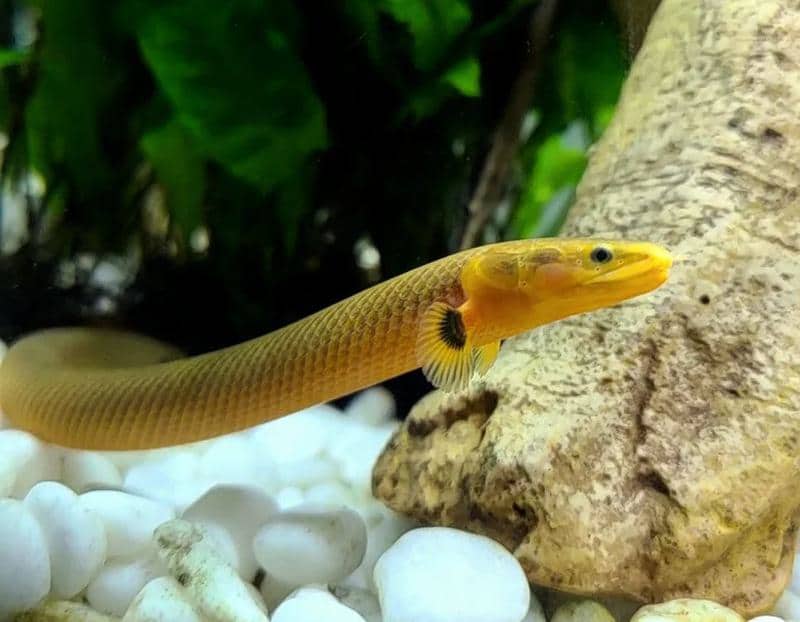
- Care Difficulty: Moderate
- Adult Size: Up to 15 inches
- Ideal Minimum Tank Size: 45 gallons
- Minimum Number: 1
- Temperament: Peaceful
- Heater: Yes (72-82°F)
The Ropefish, also known as the Reedfish or Snakefish, is an eel-like species known for its rope-like appearance. With their unique body shape and behavior, they’re attention-grabbing additions to large, well-covered aquariums.
Ropefish are peaceful but carnivorous. It’s not unusual for them to munch on smaller tank mates, especially if they can easily fit inside their mouths. We recommend keeping them with other peaceful, larger fish to avoid any missing tank mates.
They prefer dimly lit aquariums with hiding places, as they can get a bit timid. However, they’re incredible jumpers, so you should get a covered tank to keep them safe.
These aquatic creatures have a remarkable life span of up to 20 years. With their appearance, they can certainly be the highlight of any big aquarium or pond, making them a captivating addition for enthusiasts and admirers alike.
20. Royal Farlowella Catfish
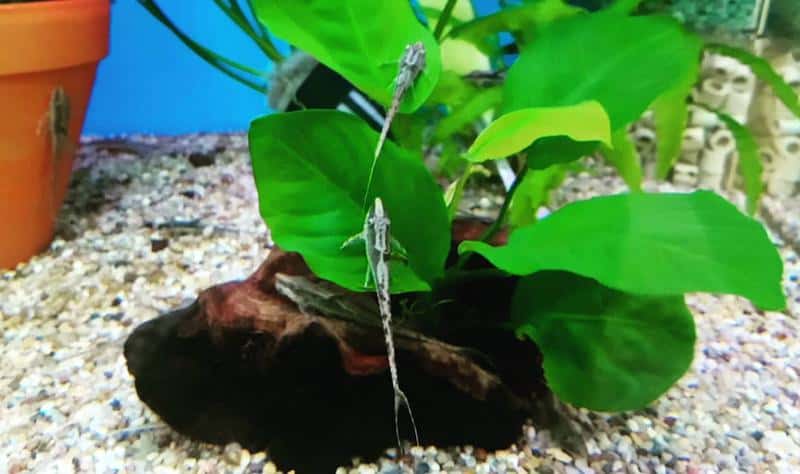
- Care Difficulty: Intermediate
- Adult Size: 9 inches
- Ideal Minimum Tank Size: 20 gallons
- Minimum Number: 1, best kept in groups
- Temperament: Peaceful
- Heater: Yes (75-79°F)
The Royal Farlowella Catfish, also known as the Twig Catfish, is a fascinating species with an elongated body covered in bony plates.
One of their main appeals is their unique appearance, which resembles a stick or twig. Their body configuration camouflages them perfectly in planted aquariums and gives them a delicate and elegant appearance.
Like their appearance, they also have pretty narrow tolerances, which means they have strict tank requirements and can easily get sick. This species is not beginner-friendly, although a novice can likely pull it off with enough preparation.
They’re peaceful and should be kept in groups to promote their natural behaviors. However, they can also survive individually or in pairs. They’re algae eaters but will accept sinking pellets and veggie-based foods. A well-established tank with plenty of driftwood and hiding spots is ideal for their care.
21. Marbled Hatchetfish (Carnegiella strigata)
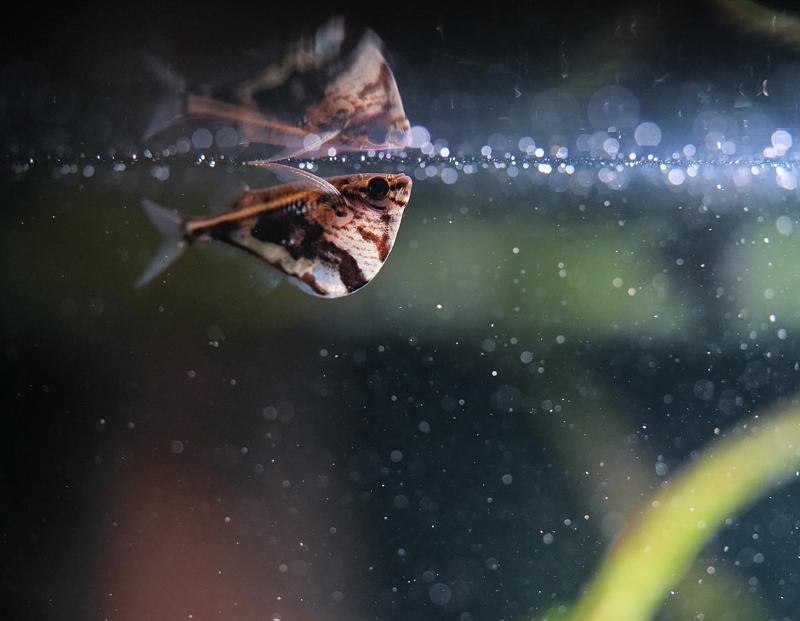
- Care Difficulty: Difficult
- Adult Size: 1.6 inches
- Ideal Minimum Tank Size: 15 gallons
- Minimum Number: 6
- Temperament: Peaceful
- Heater: Yes (74°F to 83°F)
The Marbled Hatchetfish is an amusing species with a remarkable ability to “fly” above the water’s surface in the wild. They use this superpower to leap from the water and catch insects mid-flight.
Their slender, silver body, striking marbled patterns, and large pectoral fins set them apart from other freshwater fish and will surely be a visual delight. They’re generally peaceful and prefer to be kept in groups to feel secure. However, a tightly fitting lid is essential to prevent them from jumping out of the tank.
Marbled Hatchet Fish prefer well-planted aquariums with calm water surfaces. They’re active swimmers and voracious predators, which means they appreciate plenty of live food to supplement their daily diets.
Their aerial antics and stunning appearance make them a delightful and attention-grabbing species for aquarists of all experience levels.
22. Elephant Nose Fish (Gnathonemus petersii)
- Care Difficulty: Difficult
- Adult Size: 7–10 inches
- Ideal Minimum Tank Size: 50 gallons
- Minimum Number: 6
- Temperament: Aggressive
- Heater: Yes (73–82°F)
With its long body and longer trunk-like snout, the Elephant Nose Fish is one of the most visually unique and attention-grabbing fish in the aquarium hobby.
Their long elephant trunk is an impressive electrical sensory system that allows them to navigate and communicate in the dark. In their murky natural habitats, this feature gives them impressive spatial awareness.
That said, they don’t have any scales on their body, which makes them very susceptible to changes in the water parameters and bodily injury.
They’re generally peaceful and get along well with other fish in the tank, but they still prefer quiet aquariums with low light and gentle tank mates.
23. Arowana (Osteoglossidae)
- Care Difficulty: Difficult
- Adult Size: 3 – 4 feet
- Ideal Minimum Tank Size: 300 gallons
- Minimum Number: 1
- Temperament: Aggressive
- Heater: Yes (75–85°F)
One of the most popular aquarium fishes that need almost no introduction, the Arowana is a time-tested favorite, especially among monster tank enthusiasts.
Arowanas are majestic and large freshwater fish known for their elongated body and magnificent scales. Their impressive size and graceful swimming make them a captivating centerpiece in large, well-maintained tanks.
Another notable thing about this species is its longevity, as they can live up to 20 years. Kept healthy and active, your Arowana may still be alive by the time the next generation of your family is born.
Arowanas are aggressive and require spacious tanks with excellent filtration. Due to their significant size and strict water requirements, they’re best suited for experienced aquarists with plenty of space and equipment to spare.
24. Pike Cichlids (Crenicichla lenticulata)
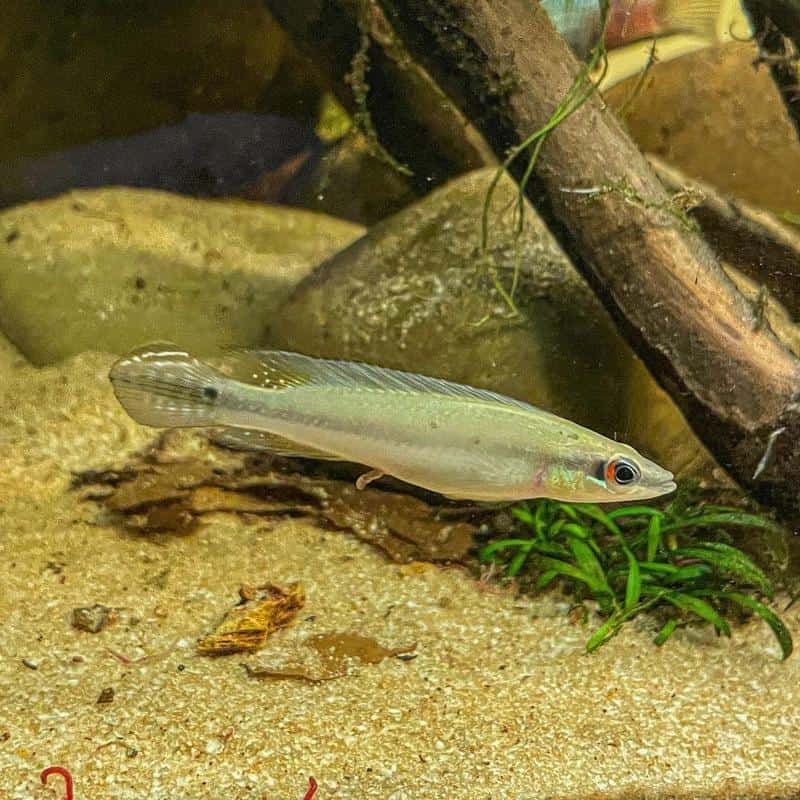
- Care Difficulty: Difficult
- Adult Size: 15 inches
- Ideal Minimum Tank Size: 90 gallons
- Minimum Number: 1 or 2 (male-female pair)
- Temperament: Very aggressive
- Heater: Yes (75-86°F)
Pike Cichlids are predatory and territorial fish known for their bold colors and noticeably aggressive behavior.
They can grow quite big at 15 inches maximum length and can outlive most other fishes with their 15-year lifespan. As a result, only hobbyists who can commit long-term should consider getting this species.
Their elongated body and sharp teeth resemble miniature freshwater “piranhas.” They require large tanks with plenty of hiding spots and a meat-based diet. We also recommend keeping them in species-only tank or with tank mates that are as big and mean as they’re.
All in all, pike cichlids are best suited for experienced aquarists who can provide the appropriate care and environment. But if you can deliver what they need, they’re certainly a cool and fascinating monster fish to have on your roster.
25. Threadfin Acara (Acarichthys heckelii)
- Care Difficulty: Difficult
- Adult Size:3 inches
- Ideal Minimum Tank Size: 75 gallons
- Minimum Number: 1 or 2
- Temperament: Aggressive
- Heater: Yes (77 – 88°F)
The Threadfin Acara, also known as the Heckelii Cichlid or Heckel’s thread-finned acara, stands out with its striking blue coloration and thread-like elongated fins.
Threadfin acaras can have a wide variety of coloration, ranging from orange and whites to yellows and blues. They also have aesthetically interesting fin configurations that can create thread effects that trail behind them as they swim.
They’re peaceful cichlids but can become territorial during breeding, so it’s best to keep them in large tanks. This is also preferable for them, as they love planted aquariums with plenty of swimming space.
They should be kept in groups or with other peaceful fish to feel secure. They’re omnivorous and can consume a wide variety of diets.
26. Female Kribensis (Pelvicachromis kribensis)
- Care Difficulty: Easy
- Adult Size: 4 inches
- Ideal Minimum Tank Size: 20 gallons
- Minimum Number: 3, with more females than males
- Temperament: Peaceful
- Heater: Yes (75–79°F)
Female Kribensis, also known as Kribs, are a colorful and entertaining freshwater fish species hailing from West Africa. These intelligent and social fish are relatively easy to care for, making them suitable for beginner and experienced fishkeepers.
They have vibrant yellow, orange, and dark blue hues that appear in horizontal bands across their body. This makes them popular for aquarium enthusiasts seeking a visually stunning centerpiece.
Providing them with plenty of hiding spots, live plants, and suitable tankmates contributes to their comfort and enhances their natural behaviors.
Kribensis are also known to be excellent parents, exhibiting attentive care for their fry, making them a sought-after species for beginner breeders.
27. Stiphodon Goby (Stiphodon semoni)
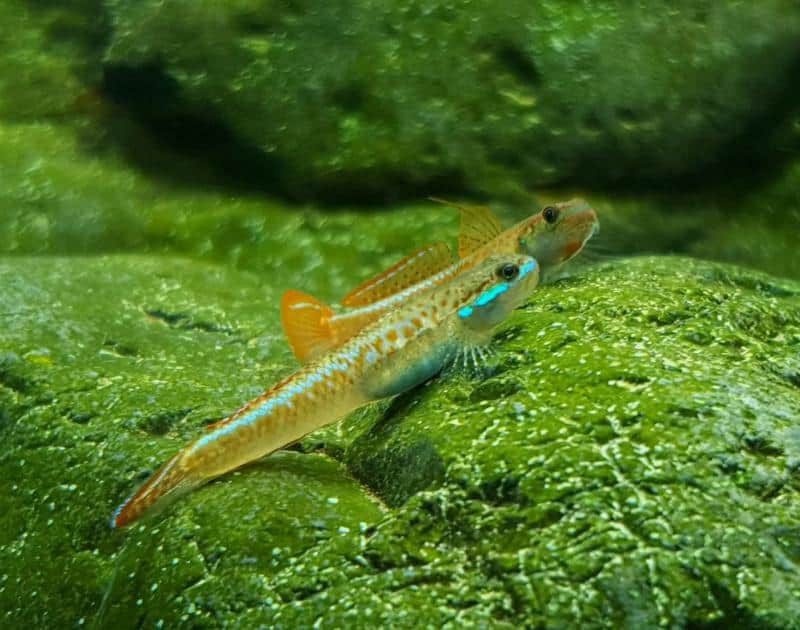
- Care Difficulty: Moderate
- Adult Size: 9 inches
- Ideal Minimum Tank Size: 15 gallons
- Minimum Number: 2
- Temperament: Peaceful
- Heater: No
The Stiphodon Goby is a small, intriguing, freshwater fish species known for its striking and vibrant colorations.
These gobies showcase an array of electric blues, oranges, and yellows, creating an eye-catching spectacle in any aquarium. They’re native to Southeast Asia’s fast-flowing streams and rivers, where they use their specialized sucker-like pelvic fins to cling onto rocks against strong currents.
Their unique adaptation means having a strong water flow in the tank is essential for their well-being. To thrive in captivity, they prefer a varied diet, including live and frozen foods.
Their captivating appearance and intriguing behaviors make them a delightful addition to any aquarist’s collection. They’re relatively peaceful and can be kept in a species-specific tank or a well-maintained community aquarium with other non-aggressive fish with the same water parameters.
28. Vampire Tetra (Hydrocyon scomberoides)
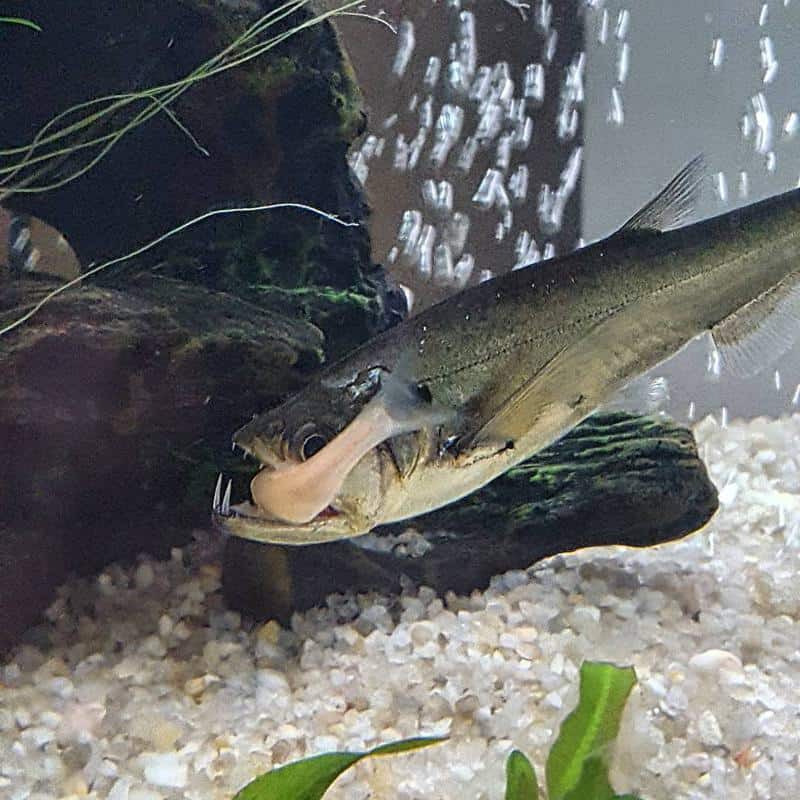
- Care Difficulty: Difficult
- Adult Size: 20 inches
- Ideal Minimum Tank Size: 500 gallons
- Minimum Number: 1
- Temperament: Aggressive
- Heater: No
The Vampire Tetra, or the Payara, is a ferocious and formidable freshwater predator native to the Amazon Basin in South America. A true monster in captivity, only experienced and dedicated fishkeepers should consider keeping this species.
Its unique name is derived from its fearsome fangs, which protrude from the lower jaw even when the mouth is closed. These teeth, resembling those of a vampire, are used to impale and immobilize prey.
Due to their predatory nature and large size, Vampire Tetras are not suitable for community aquariums. They’re best kept in large and spacious species-only tanks with very specific water conditions. Keeping them in groups can help reduce stress and aggression.
Owning a Vampire Tetra is not for the faint of heart. Still, their fearsome appearance and behavior make them a captivating challenge for seasoned aquarists.
29. Red-Tailed Black Shark (Epalzeorhynchos bicolor)
- Care Difficulty: Moderate
- Adult Size: 6 inches
- Ideal Minimum Tank Size: 55 gallons
- Minimum Number: 1
- Temperament: Aggressive
- Heater: Yes (72°–79°F)
The Red-Tailed Black Shark is an impressive freshwater fish species that boasts a deep black body with vibrant red-orange fins.
Known for their territorial behavior, these sharks should be kept as the sole representative of their species in the aquarium to prevent aggressive conflicts. They should also be grouped with large fish to avoid bullying.
They thrive in well-maintained and spacious tanks with plenty of places they can claim as territories, such as caves or driftwood. A balanced diet of high-quality pellets and occasional live or frozen foods will help keep them healthy and content in the aquarium.
The red-tailed black shark is not recommended for beginners due to its aggressive nature. Still, if you know how to handle its aggressiveness, you’re certain to enjoy its appearance and personality.
30. Bluefin Notho (Nothobranchius rachovii)
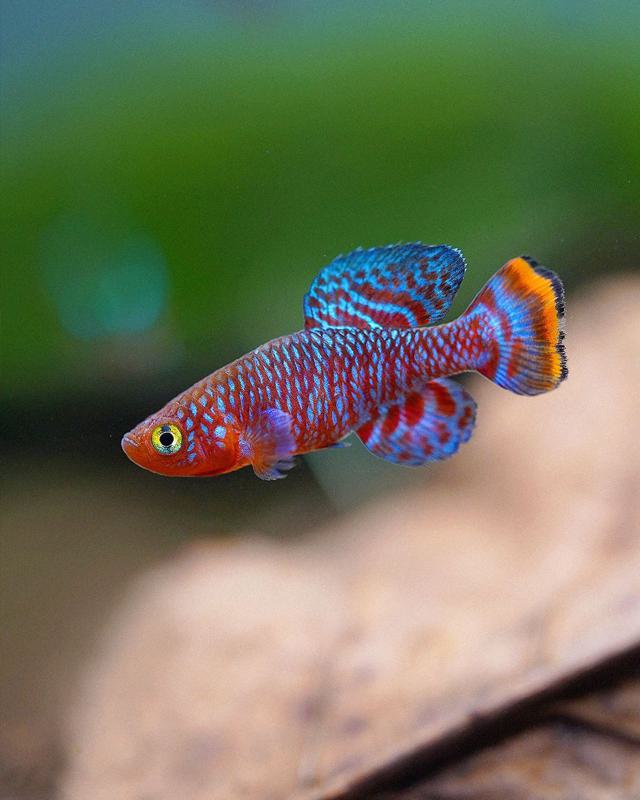
- Care Difficulty: Difficult
- Adult Size:4 inches
- Ideal Minimum Tank Size: 10–15 gallons
- Minimum Number: 3 (more females than males)
- Temperament: Peaceful
- Heater: No
The Bluefin Notho is a small and vibrant freshwater species of killifish known for its intense blue and red coloration. They have eye-catching patterns that will never fail to draw the eye and elicit compliments from any observers of your tank.
Native to seasonal ponds and swamps in East Africa, these fish have a unique life cycle thanks to their natural habitat’s temporary nature. They lay their eggs in the mud during the rainy season, and the eggs remain dormant until the next rainy season, when they hatch and grow rapidly.
It’s ideal to keep them in a species-specific setup or with other peaceful, non-nippy fish that appreciate the same water conditions. As they’re egg-layers, providing fine-leaved plants for egg-laying and a varied diet of live and frozen foods is essential for their well-being.
The bluefin notho’s unique appearance and fascinating personalities make them a prized addition to any hobbyist’s aquarium. Sadly, they have a relatively short lifespan of 9 to 12 months in captivity.
Read More:
FAQs
What’s the Most Exotic Freshwater Fish?
There’s no solid metric for the most exotic freshwater fish in the aquarium hobby, but we can guess a few fan favorites.
The Arowana with its majestic appearance, the rare Bluefin Notho, and the fearsome Vampire Tetra. Each species has unique traits and appearances that make them highly sought-after by aquarium enthusiasts.
What Is the King of Freshwater Fish?
The title of “king” is subjective, but one of the most renowned freshwater fish is the Discus. Known for their regal beauty and vibrant colors, Discus fish are often considered the epitome of elegance in the aquarium world.
Their graceful presence and stunning patterns have earned them this prestigious title across many communities and hobby niches.
What Is the Top 1 Rarest Fish?
Determining the rarest fish is challenging as rarity varies with location and availability. Some highly sought-after rare species include the Blue-Eyed Pleco (Panaque cochliodon), Panda Corydoras, and the Celestial Pearl Danio.
These elusive and unique fish are highly coveted by hobbyists, making them rare finds in the aquarium trade.
Conclusion
The world of freshwater aquarium keeping is enchanting. Making your aquarium is an experience in and of itself, but picking the coolest fish to display in your tank is arguably one of the best aspects of being a fish keeper.
There are thousands of fish varieties to choose from, each with its challenge in keeping them. We’ve barely scratched the surface in this article, but with the 30 coolest fishes we’ve discussed in detail, you now have many choices for whatever underwater world you wish to create!
